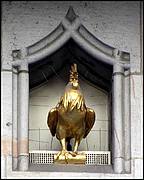
Symbology of the past … or
the present as well? - upper part of the clock

We
begin our tour from the topmost spheres. A cockerel
dominates here. It is an ancient symbol of courage and vigilance, it
welcomes the day and the Sun. In legends, ghosts and devils fly upon
the first morning cockcrow. It is a often a part of astronomical
clocks, church towers or interior clocks; it is always located in a
high position. It has been present on the Prague astronomical clock
since 1833. If it was considered to be an enhancement of protection, it
certainly proved well in the next century. On the marquise,
just next to the cockerel, two little dragons are visible at first
sight, placed symmetrically on the left and on the
right. Details
are
visible with a telescope or long telephoto objective; then we can
identify two basilisks. The basilisk has a bird’s beak, a crown, two
wings and a snakelike body. The wavy sheet metal rim of the marquise
evokes a prolonged tail. It also has the title “the king of snakes”. It
is a dangerous creature that can petrify people, animals as well as
plants with its eyes. The Prague basilisks apparently watch for any
wreckers flying around. What is peculiar is that they are near the
cockerel; basilisks are usually afraid of cockerels.
On the marquise,
just next to the cockerel, two little dragons are visible at first
sight, placed symmetrically on the left and on the
right. Details
are
visible with a telescope or long telephoto objective; then we can
identify two basilisks. The basilisk has a bird’s beak, a crown, two
wings and a snakelike body. The wavy sheet metal rim of the marquise
evokes a prolonged tail. It also has the title “the king of snakes”. It
is a dangerous creature that can petrify people, animals as well as
plants with its eyes. The Prague basilisks apparently watch for any
wreckers flying around. What is peculiar is that they are near the
cockerel; basilisks are usually afraid of cockerels.
 The
stone angel
is also where he is supposed to be. As the God’s messenger, he is in
the topmost spheres with wings bearing an unreadable message on a
flapping band. Christian angels inherited swanlike wings from Niké,
the antique goddess of victory. It is the oldest sculpture on the
clock; later it was complemented with a wooden sculpture next to the
calendar sphere, the sculpture of Archangel Michael, guardian of the
Holy City and conqueror of dragons, dark powers and iniquities. It is a
very strong protection. Archangels are superior to common angels and
there are four of them, although originally there were more of them.
Angelology, the science of angels, is very extensive; those who wish to
find out more, they will need to search in other resources. The same
applies to fallen angels, i.e. demons. They are dealt with by
demonology.
The
stone angel
is also where he is supposed to be. As the God’s messenger, he is in
the topmost spheres with wings bearing an unreadable message on a
flapping band. Christian angels inherited swanlike wings from Niké,
the antique goddess of victory. It is the oldest sculpture on the
clock; later it was complemented with a wooden sculpture next to the
calendar sphere, the sculpture of Archangel Michael, guardian of the
Holy City and conqueror of dragons, dark powers and iniquities. It is a
very strong protection. Archangels are superior to common angels and
there are four of them, although originally there were more of them.
Angelology, the science of angels, is very extensive; those who wish to
find out more, they will need to search in other resources. The same
applies to fallen angels, i.e. demons. They are dealt with by
demonology.
 Close to the angel, but partly
hidden beneath a windowsill, we can see a stripe, perhaps a scroll with
an unknown text, perhaps a stylization of a snake. We will not embark
on speculations.
Close to the angel, but partly
hidden beneath a windowsill, we can see a stripe, perhaps a scroll with
an unknown text, perhaps a stylization of a snake. We will not embark
on speculations.
The upper sculpture of the angel is one of the numerous works of the Parléř’s stoneworks, which operated in Prague since 1356 until the Hussite Wars, for over sixty years. It was King Charles IV who picked Petr Parléř; a separate chapter is devoted to him here. He had the position of a stoneworks principal, although his name in French – parleur – means something like a spokesman, foreman bricklayer, in modern meaning a “site manager”. In Prague, Petr Parléř was a principal from the very first moment. Medieval building stoneworks were strictly organized communities of stonemasons. They were not liable to local guilds, they had their own rituals within the community, both for accepting new members and for work. They adhered to the principle that experience was to be handed over solely orally. Their exclusive position made them a secret community; it is here – with masons, builders of cathedrals – where the later name of secret associations, freemasons, originated. Building stoneworks were gradually disbanded as an organization as the demand for cathedrals decreased.
